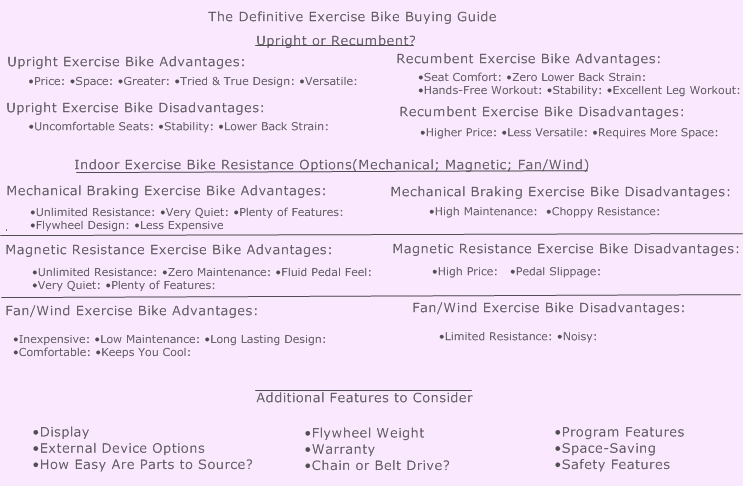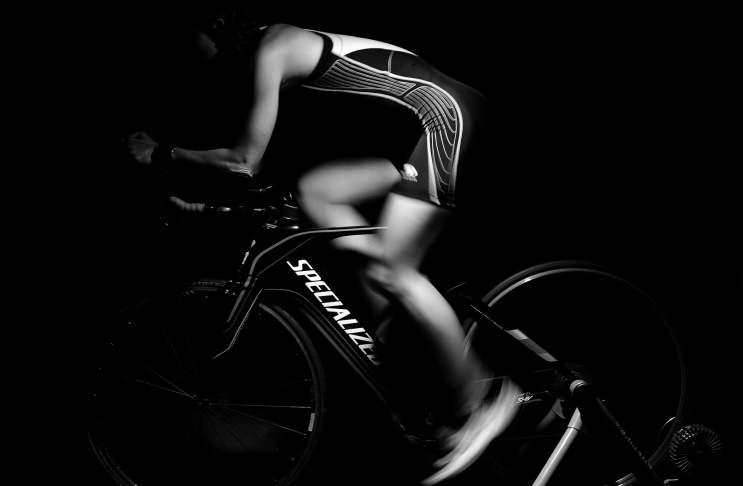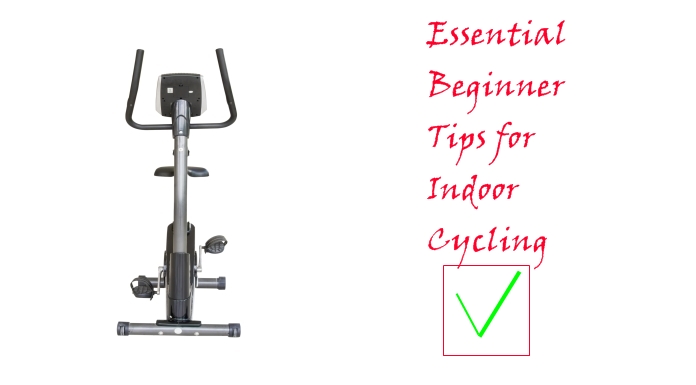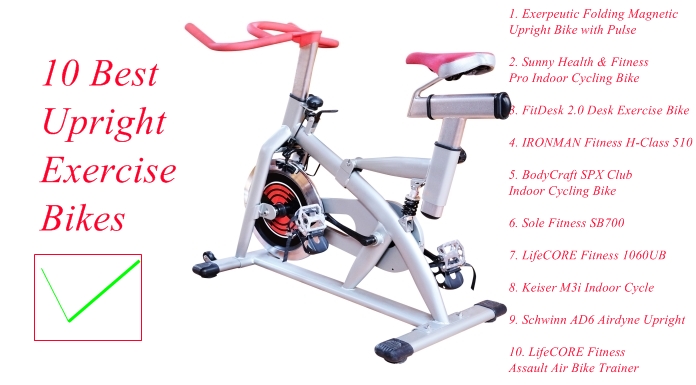Nothing beats the feeling of hitting the open road from the warm comforts of your own home. While cycling enthusiasts prefer the real thing; uncooperative weather conditions, safety concerns and physical limitations mean that some of you will prefer putting miles on a stationary exercise bike instead.
When it comes time to purchase, there are many more factors to consider than most first time exercise bike buyers initially think.
Will you prefer the realism offered by an upright design, or does the comfort of a recumbent appeal more to you?
Do you even know the difference between the two for that matter?
Then there are still other factors to consider, such as different resistance types along with their advantages and disadvantages. Then, one has to consider value added features like LCD displays, programmed workouts, device connectivity, and the various space saving features offered by the manufacturer.
Basically, there’s a lot to consider in order to get a machine you’re happy with and comfortable riding.
Keep reading and you’ll soon know everything you need to in order to make the best buying decision for your needs and preferences.
Upright or Recumbent?
There are two main types of indoor exercise bikes: Upright or Recumbent.
Uprights have the same design, dimensions and ride positioning of a typical road bike:
Upright Exercise Bike Advantages:
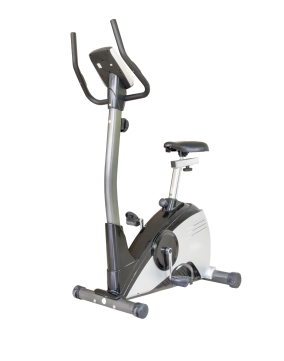
• Price: Though there’s less of a price gap between the two as time goes on, when comparing similar quality brands and resistance types, uprights are still the cheaper option over a recumbent bike.
• Space Saving: Uprights take up less space while in use and if the option’s available, many will fold up to less than half their in-use footprint for storage purposes.
• Greater “Bike” Feel: You can’t stand up and pedal on a recumbent like you would when riding a bike on the road. Recumbent exercise bikes feel unnatural to most who’re used to road bikes.
• Tried & True Design: Not much to say here. Uprights are designed to emulate the same bike design that’s existed for a couple of centuries now.
• Versatile: Riding an upright is like riding a road bike. You can work out exactly like you would on a bike, climbing hills and doing sprint runs – minus the weather and stones flying at your head from car tires!
Upright Exercise Bike Disadvantages:
• Uncomfortable Seats: Anyone who’s ever ridden a road bike knows there’s only so much you can do to keep your tailbone from feeling some discomfort when doing long rides.
• Stability: Since uprights are shorter and more compact, some models can be tipsy and feel unbalanced.
• Lower Back Strain: This is just another reality of riding a traditionally designed bike – indoors or otherwise.
Recumbent designs place the pedals well in front of the rider, have larger and more comfortable seats, yet take up considerable more space than an upright:
Recumbent Exercise Bike Advantages:

• Seat Comfort: Since you’re pushing your legs forward instead of pumping them underneath your seat, the seats can be made wider and outfitted with better padding material.
• Zero Lower Back Strain: The design of the recumbent allows you to keep your back straight even while using lots of resistance, meaning you never have to lean forward while pedaling.
• Hands-Free Workout: Since the seat is wider and the bike more stable, you don’t have to use your hands to stabilize the bike.
• Stability: Recumbent exercise bikes are wider, longer, and heavier, leading to better balance for the rider.
• Excellent Leg Workout: Using a recumbent bike is like a combination leg press/cycling exercise. You’ll feel more of a burn directly in the muscles of your legs.
Recumbent Exercise Bike Disadvantages:
• Higher Price: Recumbent designed exercise bikes come with a higher price tag due to their niche popularity and the increase in raw materials needed to make them.
• Less Versatile: You’re basically stuck in your seat – no standing or intense wild sprint simulations like you’d get on a road bike or upright indoor exercise bike.
• Requires More Space: A good sturdy model will require more space while working out and few fold up to half or less of their in-use footprint for storage.
Note About Dual Purpose Exercise Bikes
There are also dual purpose exercise bikes which use a front-mounted fan for resistance. They use pedals and pivoting handlebars to propel the fan with. Dual purpose bikes are in a different class of their own and are not usually recommended for beginners or casual users. If you’re interested in purchasing one, they can be lumped in among the wind/fan resistance model exercise bikes listed further down the page.
Indoor Exercise Bike Resistance Options
Mechanical Resistance
Exercise bikes using a mechanical braking system have been around for decades. The pedals are connected to a flywheel by a chain or belt drive and that flywheel is slowed by resistance pads made of the same material automotive brake pads use. As the user increases the resistance, the pads push or squeeze tighter to the flywheel creating more friction, thus making it harder to pedal.
Most modern mechanical resistance models allow for the intensity to be changed from a lever on the handlebars. Older and/or cheaper models require the rider to dismount to do so.
Mechanical Braking Exercise Bike Advantages:
• Unlimited Resistance: There’s no limit to the resistance created by a mechanical system. Most will adjust to the point where it’s impossible to move the pedals!
• Very Quiet: This type of exercise bike is very quiet. Brand quality does matter, however. The material used to make the wearable resistance pads can be noisier on some more than others.
• Plenty of Features: How much are you willing to spend? These bikes offer all the perks and options you could ask for.
• Flywheel Design: Because they use a flywheel attached to the pedal mechanism; ride and resistance quality are far superior to fan/wind resistance models.
• Less Expensive Than a Mag Bike: This is debatable, as you eventually have to replace the resistance pads. However, mechanical models are usually less expensive to purchase than mag bikes.
Mechanical Braking Exercise Bike Disadvantages:
• High Maintenance: The resistance pads have to be changed in proportion to how much you use your bike. A casual user might only replace the pads every 10 years. A daily user might find they’re replacing pads every few years – even less.
• Choppy Resistance: Particularly as you turn the resistance up, the pedal can start to feel choppy – not as fluid as the pedal travel on a road bike would feel. If you haven’t ridden a real bicycle recently, this drawback may not concern you.
Magnetic Resistance (“Mag” Exercise Bikes)
Magnetic resistance exercise bikes use a similar setup to their mechanical resistance counterparts. However, they offer the added advantage of using magnetic force to slow the flywheel attached to the pedals via a chain.
The magnetic force is created by the turning of the flywheel. The parts used to create the magnetic resistance rarely, if ever, require replacement.
Magnetic Resistance Exercise Bike Advantages:
• Unlimited Resistance: As with mechanical resistance exercise bikes, magnetic resistance models offer limitless resistance options for home users.
• Zero Maintenance: The resistance pads do not wear. If you purchase a chain driven model, a quality magnetic exercise bike can last a decade or more before the chain or various bearings on the pedals and flywheel require maintenance.
• Fluid Pedal Feel: The magnetic resistance feature, coupled with a heavy balanced flywheel makes for the most realistic and fluid pedal feel.
• Very Quiet: You can watch television, listen to an iPod, or enjoy a nice book or magazine while riding in relative noise-free comfort.
• Plenty of Features: Magnetic exercise bike manufacturers offer all the modern features home users are looking for.
Magnetic Resistance Exercise Bike Disadvantages:
• Price: Because they last virtually forever and contain the most sophisticated flywheel and resistance, expect to pay more for a mag bike. Even more if you want a quality display with plenty of monitoring options and the ability to sync with your bluetooth devices.
• Pedal Slippage: A poorly-designed mag bike can suffer from pedal slippage. This takes place when the rider starts to pedal too aggressively all of a sudden and manages to break the magnetic resistance force at the flywheel. This rarely ever happens with quality-manufactured bikes and usually requires a lot of strength too.
Fan/Wind
Exercise bikes that use an impeller mounted on the front of the bike for resistance are the most inexpensive and simple design available. As you pedal, several carefully spaced vanes mounted on the impeller catch air and create resistance.
The harder you pedal the more resistance is created. This design has been used for over a century now and also eliminates the need to have an electric fan nearby on the hot days!
Fan/Wind Exercise Bike Advantages:
• Inexpensive: It’s not impossible to find one of these for less than $100. Don’t expect any value added options at that price though.
• Low Maintenance: There isn’t much that can break on a fan/wind resistance exercise bike. Like the mag bikes, you can expect a decade or more of maintenance free use before the chain or bearings require service.
• Long Lasting Design: Ask around and you likely know somebody with a fan bike from the 60s or 70s still in working condition lying around their house!
• Comfortable: Spend a few dollars extra and you can get a model with a really comfortable seat and handlebar cushions.
• Keeps You Cool: Nothing beats a fan blowing on your face that only requires the very calories you’re trying to burn in order to run!
Fan/Wind Exercise Bike Disadvantages:
• Limited Resistance: There is actually a lot of resistance offered on a well-designed fan exercise bike. However, eventually if you pedal hard enough, the resistance maxes out.
• Noisy: Think of the noise an industrial-sized fan makes when you’re sitting right beside it. They’re loud!
Additional Features to Consider
Display
There’s nothing wrong with buying a barebones exercise bike if tracking your speed, mileage, heart rate, etc., aren’t important.
If these factors are important, then you’ll want a quality LCD display that offers the monitoring features you want currently and even those you might use in the future, such as WiFi and bluetooth connectivity.
Even cloud storage is something that’s offered with certain manufacturers and the proprietary apps they have programmed into their displays.
External Device Options
You might want to connect to your exercise bike using a chest strap for monitoring heart rate and blood pressure while you exercise.
Additionally, there are thousands of apps available on iTunes and the Google Play store to use your smart device to help you workout better and track progress.
If this is important, make sure the display has bluetooth or at least accepts a USB input for your devices.
How Easy Are Parts to Source?
This is a slightly different consideration than the warranty requirements described next. If you’re buying a mechanical resistance unit, you will have to replace the pads in 2 – 10 years. Buy a replacement set upfront if you can, in case production stops before you need them.
Consider the same if your bike has a belt-driven pulley. In this case, purchasing up to two replacement belts with the machine is advised.
You shouldn’t need to replace many other parts on your exercise bike with any regularity. However, the seat can wear over time, as can handlebar handles and electronic parts such as the speedometer sensor and possibly the display.
It’s best to go with a reputable company that’s been around for a while just to be sure those replacement parts will be there down the road if you need them.
Warranty
Look for a 1 – 3 year warranty on the moving parts such as bearings.
Also, look for the same guarantee on the frame. Cheap or poorly made welds can and do fail occasionally and the bike will be useless if not repaired.
Most manufacturers will offer a year of free labor and parts to repair, then require you pay for any labor costs thereafter for the remainder of the parts warranty.
Extended warranties often aren’t worth the cost, as most manufacturing kinks should show themselves during the warranty period.
Chain or Belt Drive?
The choice is yours however, the best advice is to always choose a chain-driven drive design over a belt-driven one.
Chains can last virtually forever on a home exercise bike, perhaps requiring a little oiling now and again as they start to age.
Belts will inevitably crack, wear, slip and eventually break. A higher price doesn’t necessarily mean you’ll be getting a chain drive either; some high end bikes will include a belt instead.
Read the product details carefully!
Flywheel Weight:
This only applies to a mechanical braking or magnetic resistance type indoor bike. Though mechanical braking can be more forgiving of a lighter flywheel, either design with a heavy flywheel will always prevail when it comes to ride quality and comfort.
Not to mention that how comfortable the bike is to pedal also directly affects the wear and tear on your bottom (read: your tailbone) which can wear out your arms and upper body as you strain to keep your body-weight off your posterior section.
A 40-pound flywheel is generally considered the starting point when it comes to years of comfortable use. Heavier is even better.
Program Features
This won’t be important to everyone. However, if you’re easily bored and don’t plan to connect via a smartphone app to guide you through different workouts, consider how many built in programs the display offers. Generally 10 or 20 programmed workouts will be plenty for most people.
Space-Saving
If space is at a premium in your workout area, or you plan to store the bike in a closet or corner while not in use, you’ll want to examine the dimensions of the bike carefully.
Generally, the less space a bike takes up while in use, the less stable it will be when pedaling aggressively.
If balance is important to you, you’ll want to look for a machine that has built in space-saving features such as parts that fold or tuck to reduce the footprint by one or two-thirds while not in use.
Safety Features
All you can do is look at the design and decide whether it’s safe. Are there any dangerous-looking moving parts that are exposed? If so, do you or will you have children around the bike at any time that will be potentially unsupervised?
Asking these questions before you buy will ensure nobody, including you, gets hurt due to design flaws.
The Verdict: Deciding What Exercise Bike is Right for You
While wind resistance models are an inexpensive way to start your indoor riding adventure, they’re far from preferable if you’re looking for a stationary biking experience that emulates the feeling of riding on the road, or “road feel” as it’s often referred to as.
Exercise bikes that use wind resistance are fine if you’re just looking for a decent workout and calorie burn. If you want to feel like you’re actually riding a bike, you’ll quickly regret the decision to buy during the first 5 minutes of riding one.
How the Right Flywheel Makes All the Difference
For most of you, the real decision will come down to whether you want to go with a mechanical or magnetic (mag) resistance model of exercise bike.
Keeping in mind that flywheel weight and balance are what determines overall pedal resistance and comfort, the choice will come down mostly to budget and perhaps, personal preference.
Save Money Now or Save Money Later?
If you’ve used an exercise bike that uses mechanical resistance, and it feels good to you and you don’t mind spending money on extra resistance pads down the road, you can save a few bucks upfront going that route.
All that being said: while you save a little money upfront, mechanical models are known for their choppy ride feel, the resistance parts run much hotter (ie., heat = premature part failure), and the resistance can get unpredictable as the pads begin to wear down too.
Mag bikes run cool and quiet, they best emulate a true outdoor riding experience, and can last for decades with careful use.
Real Ride Experience or Pedal While You Lounge?
You’ve already likely decided whether you want the relaxing comfort of a recumbent versus the less comfortable but more realistic stand upright design.
Upright exercise bikes are for the more serious and or fit indoor cyclists.
Recumbent bikes are perfect if you want to watch television or read a magazine while you pedal and/or you have physical ailments or disabilities that favor the ability to lie back a bit.
Best Overall Value: Mag Exercise Bikes (Upright or Recumbent)
If you want the best ride, most longevity and best overall value; there’s no reason not to purchase a magnetic resistance model with a nice weighty flywheel right out the gates – in either an upright or recumbent design.
Mag exercise bike prices are slowly starting to come in line with mechanical braking models and they’ve proven themselves to provide the most realistic riding experience. You’ll rarely encounter problems with parts failing either.
Hopefully now you feel better informed about how to make the right choice between the various models and designs of stationary exercise bikes.
Happy riding!

